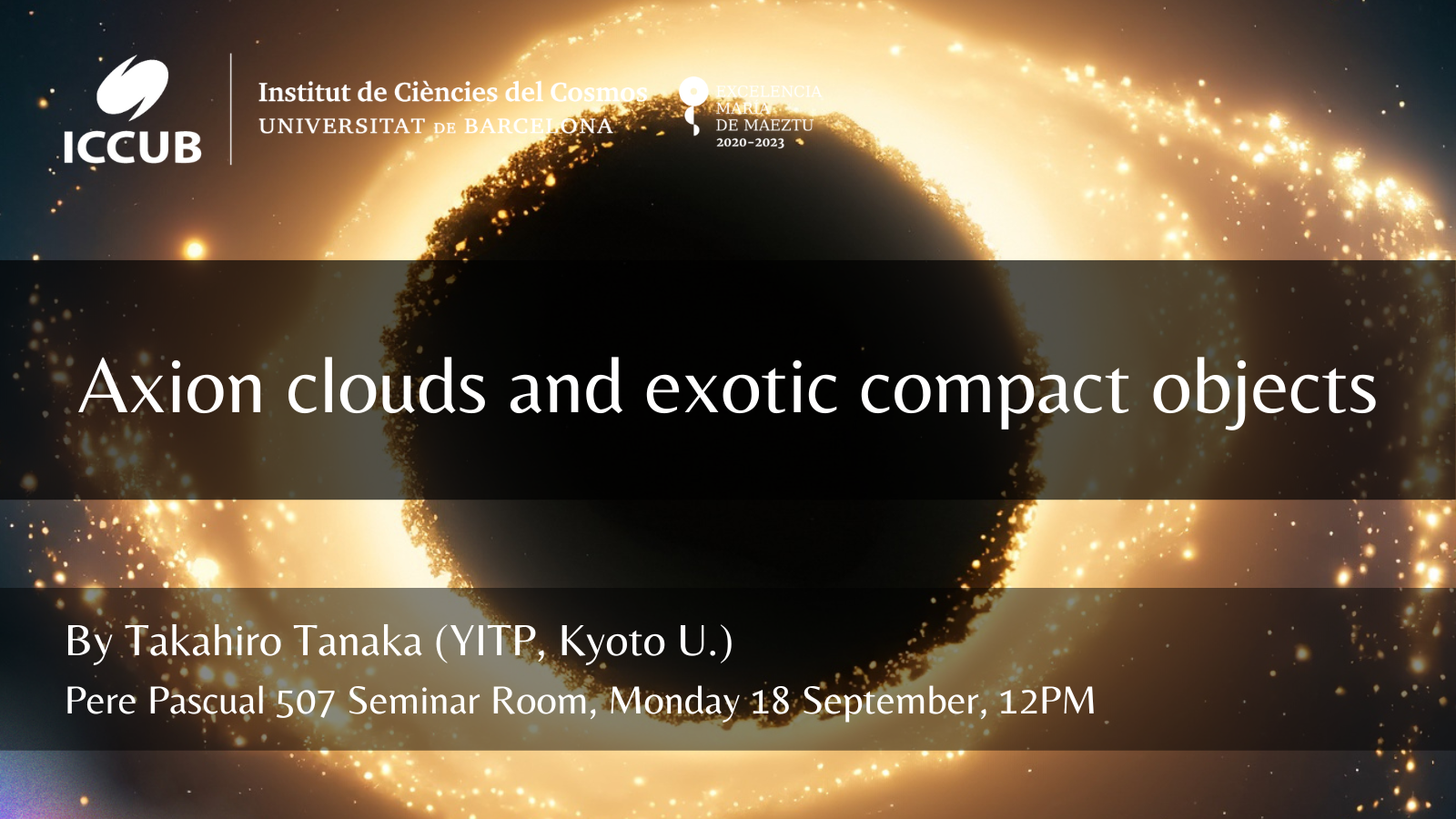BIG&C Meetings: Barcelona Initiative for Gravitation and Cosmology
The BIG&C (Barcelona Initiative for Gravitation and Cosmology) aims to bring together all actors working in the field of gravity and cosmology in Barcelona, from observations to theory.
These series of meetings has the purpose to set an informal stage for the exchange of ideas and to encourage joint discussions on relevant topics in the field. It also provides the opportunity for people working in Barcelona to get informed on the lines of research of the other institutes.
PROGRAM:
12PM: "Axion clouds and exotic compact objects" by Takahiro Tanaka (Kyoto U.)
Axion clouds are thought to form spontaneously around rotating black holes due to superradiance. Research is underway to find the existence of Axion by capturing traces of these clouds. Here, we discuss the influence of self-interactions and tidal interactions on the evolution of axion clouds. Furthermore, boson stars are often discussed as alternative compact objects to black holes, but its formation process is less clear. We will discuss what scenarios are possible for compact boson star formation.

2:30PM: "The impact of gravitational wave memory in parameter estimation of massive binary black holes" by Silvia Gasparotto (IFAE)
Besides the transient effect, the passage of a gravitational wave also causes a persistent displacement in the relative position of an interferometer’s test masses through the nonlinear memory effect. This effect is generated by the gravitational backreaction of the waves themselves, and encodes additional information about the source. In this work, we explore the implications of using this information for the parameter estimation of massive binary black holes with LISA. Based on a Fisher analysis for nonprecessing black hole binaries, our results show that the memory can help to reduce the degeneracy between the luminosity distance and the inclination for binaries observed only for a short time (∼few hours) before merger. To assess how many such short signals will be detected, we utilized state-of-the-art predictions for the population of massive black hole binaries and models for the gaps expected in the LISA data. We forecast from tens to few hundreds of binaries with observable memory, but only ∼O(0.1) events in 4 years for which the memory helps to reduce the degeneracy between distance and inclination. Based on this, we conclude that the new information from the nonlinear memory, while promising for testing general relativity in the strong field regime, has probably a limited impact on further constraining the uncertainty on massive black hole binary parameters with LISA.

3:30PM: "Non-perturbative Wavefunction of the Universe in Inflation with (Resonant) features" by Vicharit Yingcharoenrat (IPMU, Tokyo)
I will first discuss a motivation why one needs to go beyond perturbation theory (PT) in inflation as going to the tail of the distribution of the primordial fluctuations. Then I will propose that the way to go beyond PT is equivalent to performing a calculation in the semi-classical limit which captures classical non-linearities at the non-perturbative level. I will move to the application of our non-perturbative method in the resonant inflationary models, in which the inflaton potential exhibits a small oscillatory modulation. As a result, given a late-time profile of the primordial fluctuations, their probability distribution function features a non-perturbative behaviors, for example, the oscillation in the late-time field value. Finally, I will show that this result can be analytically studied using the saddle-point approximation.

5PM: "Towards quantum gravity constraints from S-matrix" by Katsuki Aoki (YITP, Kyoto University)
The S-matrix unitarity and causality have gained renewed interest recently in understanding the possible structures of low-energy effective field theories and quantum gravity. However, there are obstructions to applying it to gravitational EFTs due to the massless spin-2 nature of the graviton. First, I will discuss that under a certain assumption on the UV spectrum of quantum gravity, the GUT scale naturally arises from the consistency of the standard model of particle physics and general relativity. Furthermore, under the same assumption, the parameter space of dark photons is strongly constrained, ruling out the light mass range by combining theoretical and observational constraints. If I have time, I will talk about some progress for obtaining constraints on unstable states of a theory, which may be crucial to elucidating possible UV spectra of quantum gravity.

